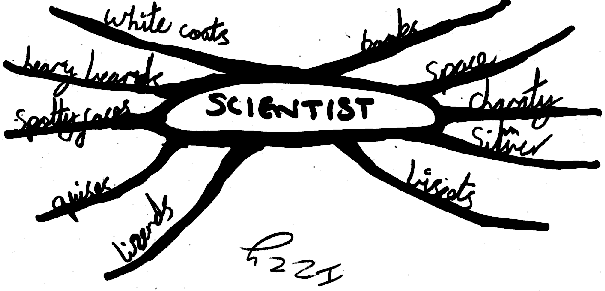A.i The children’s perceptions of science, scientists and bacteria
In order to quickly obtain a picture of the children’s perceptions to these concepts, three blank "mini mind maps" (Buzan and Buzan, 1993) were given to each child. Each mind map consisted of a single, central word and ten radiating branches. The children were asked to add one or two words of immediately perceived association (though, not necessarily definition), to each branch. This was to be done in the shortest possible time, with minimal analytical thought.
The following examples (Figs. A.1, A.2 and A.3) are reasonably representative of the children’s responses. The fourth map (Fig. A.4), given for comparison, came from a student teacher at Cavendish School.
|
Figure A.1:
|
Pens; Mad professor Snack; Chemicals Electric sparks; Bottles Bin; Chemisrty set Document paper; Mad experiments |
| Figure A.2:
|
White coats; Books Hairy beards; Space Spotty faces; Charity Quizes; Silver Lizards; Biscuits |
| Figure A.3: 
|
Microscopic view; Disease Dirt; Stain Science; Creature Infection; Spots Germs; Poison |
| Figure A.4: 
|
White coats; Bunsen burners Explore; Bulls’ eyes Photosynthesis; Explosions Laws; Equations Experiment; Discovery |
The children’s mind maps, in general, seem to confirm some assertions made in Introduction: Science in society. For example, perceptions of scientists seem to be of eccentric, unkempt and asocial characters, wearing white coats and mixing dangerous chemicals.
The student teacher appeared to centre on the aspired methodological path to truth, i.e. experiment, exploration, discovery and law.
Fig. A.3 illustates well the commonplace, one-sided impression of bacteria as harmful agents of disease.
A.ii The children’s thoughts about who scientists are and what they do
Generally, scientists were thought to do experiments to find things out that might help us, such as finding new medicines or making new kinds of pets (?!).
The most resonant association was with space. Scientists were known to send satellites into space, or become astronauts, to find out about planets. This was done partly just for the sake of it, but also to "find things harder than diamonds" and "to get water from the Moon."
Scientists make machines and computers to make money, so that people can be richer. They work in labs and make new kinds of food that you can send into space, such as ice-cream that never melts. They also make tablets for nourishment, so that you don’t have to spend time eating big meals, if you are in a hurry. These tablets can be made better than real food and give you lots of energy.
Generally, the children perceived scientists to be doing high-profile, state-of-the-art work, for the benefit of society. This "noble pioneer" perspective strikes a chord with the student teacher’s mind map that suggested exploration and discovery. Indeed, the association of "charity" with "scientist" by one of the children also fits this theme. However, the children’s mind maps tended to centre on scientists’ perceived oddity, rather than nobleness.
![]()
[Progressive
links] ![]() [Home]
[Home]![]()
![]() ...
back to the report
...
back to the report